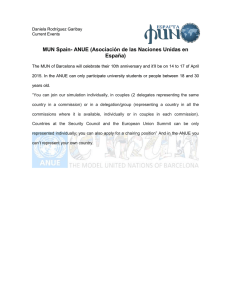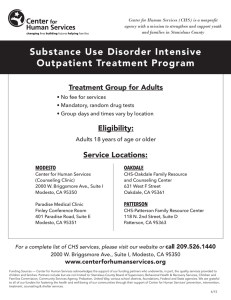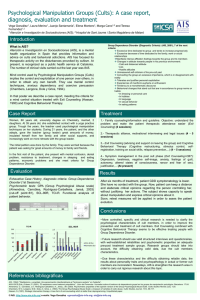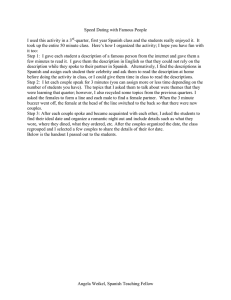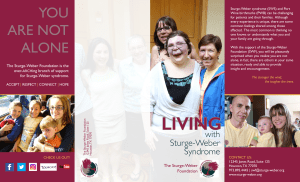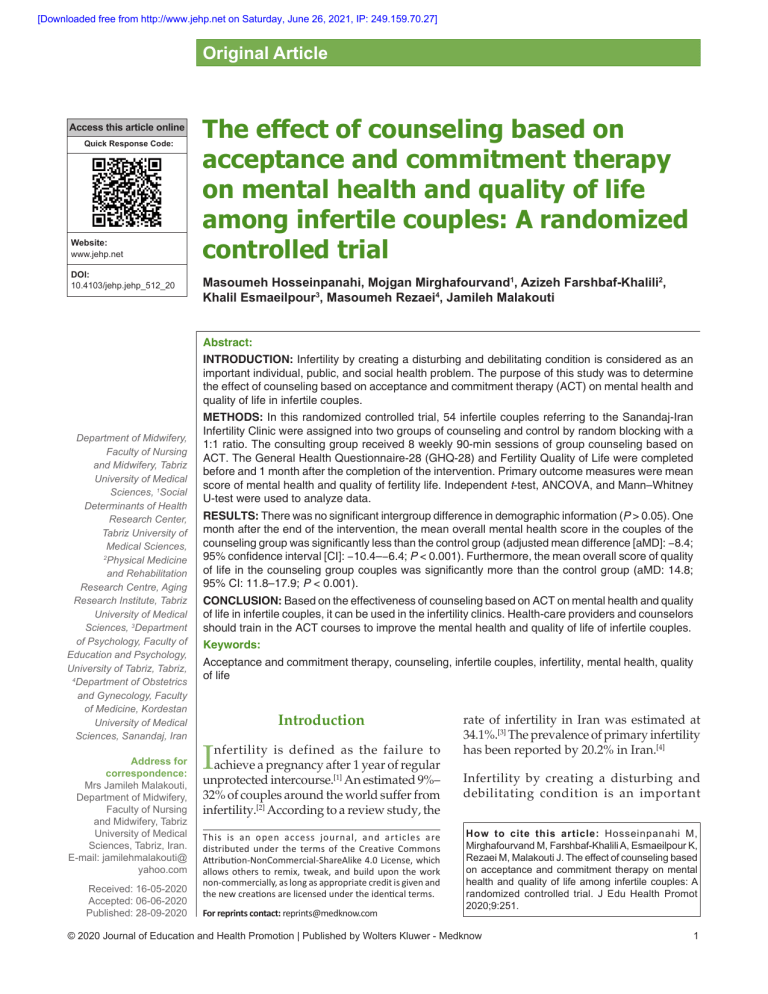
[Downloaded free from http://www.jehp.net on Saturday, June 26, 2021, IP: 249.159.70.27] Original Article Access this article online Quick Response Code: Website: www.jehp.net DOI: 10.4103/jehp.jehp_512_20 The effect of counseling based on acceptance and commitment therapy on mental health and quality of life among infertile couples: A randomized controlled trial Masoumeh Hosseinpanahi, Mojgan Mirghafourvand1, Azizeh Farshbaf‑Khalili2, Khalil Esmaeilpour3, Masoumeh Rezaei4, Jamileh Malakouti Abstract: INTRODUCTION: Infertility by creating a disturbing and debilitating condition is considered as an important individual, public, and social health problem. The purpose of this study was to determine the effect of counseling based on acceptance and commitment therapy (ACT) on mental health and quality of life in infertile couples. Department of Midwifery, Faculty of Nursing and Midwifery, Tabriz University of Medical Sciences, 1Social Determinants of Health Research Center, Tabriz University of Medical Sciences, 2 Physical Medicine and Rehabilitation Research Centre, Aging Research Institute, Tabriz University of Medical Sciences, 3Department of Psychology, Faculty of Education and Psychology, University of Tabriz, Tabriz, 4 Department of Obstetrics and Gynecology, Faculty of Medicine, Kordestan University of Medical Sciences, Sanandaj, Iran Address for correspondence: Mrs Jamileh Malakouti, Department of Midwifery, Faculty of Nursing and Midwifery, Tabriz University of Medical Sciences, Tabriz, Iran. E‑mail: jamilehmalakouti@ yahoo.com Received: 16‑05‑2020 Accepted: 06‑06‑2020 Published: 28-09-2020 METHODS: In this randomized controlled trial, 54 infertile couples referring to the Sanandaj‑Iran Infertility Clinic were assigned into two groups of counseling and control by random blocking with a 1:1 ratio. The consulting group received 8 weekly 90‑min sessions of group counseling based on ACT. The General Health Questionnaire‑28 (GHQ‑28) and Fertility Quality of Life were completed before and 1 month after the completion of the intervention. Primary outcome measures were mean score of mental health and quality of fertility life. Independent t‑test, ANCOVA, and Mann–Whitney U‑test were used to analyze data. RESULTS: There was no significant intergroup difference in demographic information (P > 0.05). One month after the end of the intervention, the mean overall mental health score in the couples of the counseling group was significantly less than the control group (adjusted mean difference [aMD]: −8.4; 95% confidence interval [CI]: −10.4–−6.4; P < 0.001). Furthermore, the mean overall score of quality of life in the counseling group couples was significantly more than the control group (aMD: 14.8; 95% CI: 11.8–17.9; P < 0.001). CONCLUSION: Based on the effectiveness of counseling based on ACT on mental health and quality of life in infertile couples, it can be used in the infertility clinics. Health‑care providers and counselors should train in the ACT courses to improve the mental health and quality of life of infertile couples. Keywords: Acceptance and commitment therapy, counseling, infertile couples, infertility, mental health, quality of life Introduction I nfertility is defined as the failure to achieve a pregnancy after 1 year of regular unprotected intercourse.[1] An estimated 9%– 32% of couples around the world suffer from infertility.[2] According to a review study, the This is an open access journal, and articles are distributed under the terms of the Creative Commons Attribution‑NonCommercial‑ShareAlike 4.0 License, which allows others to remix, tweak, and build upon the work non‑commercially, as long as appropriate credit is given and the new creations are licensed under the identical terms. For reprints contact: [email protected] rate of infertility in Iran was estimated at 34.1%.[3] The prevalence of primary infertility has been reported by 20.2% in Iran.[4] Infertility by creating a disturbing and debilitating condition is an important How to cite this article: Hosseinpanahi M, Mirghafourvand M, Farshbaf-Khalili A, Esmaeilpour K, Rezaei M, Malakouti J. The effect of counseling based on acceptance and commitment therapy on mental health and quality of life among infertile couples: A randomized controlled trial. J Edu Health Promot 2020;9:251. © 2020 Journal of Education and Health Promotion | Published by Wolters Kluwer - Medknow 1 [Downloaded free from http://www.jehp.net on Saturday, June 26, 2021, IP: 249.159.70.27] Hosseinpanahi, et al.: The effect of counseling based on acceptance and commitment individual problem.[5] Both infertility and its treatment techniques are associated with serious mental issues. [6,7] Infertility stress and anxiety can cause marital maladjustment, sexual dysfunction, reduced self‑confidence, and reduced sexual relationship,[8] and in many infertile couples, these problems may prevent the continuation and completion of the treatment.[9] A study has reported that the divorce rate is 3.7 times higher in infertile women.[10] In addition, the prevalence of depression in this group equals to cancer‑ or heart disease‑induced depression.[11] In recent years, the mental health of infertile couples has been given a serious attention, and infertility has been an undeniable severe experience of helplessness for many couples.[12] According to the World Health Organization (WHO), mental health is defined as “subjective well‑being, perceived self‑efficacy, autonomy, competence, intergenerational dependence, and self‑actualization of one’s intellectual and emotional potential among others.”[13] In a study, the presence of mental disorders was reported in 40.2% of infertile women, with a prevalence of 23.3% for general anxiety disorder, 17% for major depression, and 9.8% for chronic depression.[14] Peterson and Eifert (2011) observed severe depressive symptoms in 11.6% of infertile women and 4.3% of infertile men.[15] Many studies have shown that infertility has a negative effect on the quality of life.[16] The WHO defines the quality of life as “an individual’s perception of his/her position in life in the context of the culture and value systems in which he/she lives and in relation to his/her goals, expectations, standards and priorities.”[7] A systematic review study showed that infertility affects couples in the following four aspects of their life including mental health, marital relationships, sexual relationships, and quality of life.[17] Irrational beliefs about the parenthood and economic burden of infertility treatments have an adverse impact on mental health of this group of patients, necessitating psychological and counseling supports.[16] One of the most important approaches in this regard is counseling.[18] Acceptance and commitment therapy (ACT) is a novel technique for behavioral therapy that employs mindfulness, acceptance, and cognitive diffusion skills to enhance psychological flexibility and prevent behavioral changes in favor of chosen values.[19] Given the high prevalence of infertility and its adverse individual and social effects, the importance of mental health in this group, lack of using ACT in Iranian infertile couples, and previous recommendation of a meta‑analysis study for further study on the effect of ACT on quality of life,[20] this study aimed to determine the impact of counseling based on ACT on mental health and quality of life in infertile couples. Holding counseling classes in centers can be 2 a successful step in improving the quality of provided services and achieving healthier communities and greater prosperity. Methods Study design and participants This randomized controlled trial was carried out on 54 infertile couples (both spouses), referring to the Besat Infertility Clinic in Sanandaj, Iran, between July 23, 2017, and February 20, 2018. Inclusion criteria included couples with initial infertility of 1–10 years, couples 20–45 years old, having at least reading and writing literacy, and at least once failed treatment of infertility experience. Exclusion criteria included earning a score of 41 from the Mental Health Questionnaire, occurrence of an unpleasant event during the 6 months before the study (death or acute illness of relatives), not having any known mental or physical illness such as diabetes, depression (according to the participant’s statement), participation in another intervention study, and positive pregnancy test during the sampling and intervention. Sample size The estimated sample size was 10 based on Narimani et al.’s study[21] into the quality of infertile women’s life (Narimani et al., 2014), considering m1 = 11.05, m2 = 13.44, SD1 = 1.32, SD2 = 1.76, test power of 80%, and one‑sided α = 0.05. In addition, the estimated sample size was 24 based on Hashemi et al.’s study[22] into infertile women’s mental health (Hashemi et al., 2014), considering m1 = 41.83, m2 = 33.47, SD1 = 11.46, SD2 = 1, test power of 80%, and one‑sided α = 0.05. As a result, since the sample size was greater based on the mental health, the ultimate sample size estimation was 27 couples, considering a possible sample loss of 10%. Sampling For sampling, the researcher attended at the infertility clinic to obtain the phone numbers of the infertile couples. Then, through phone calls, the researcher was introduced and they were informed about the general objective of the study and provided with a brief description of the research. In this stage, the initial enrollment of the consenting infertile couples was performed, and they were scheduled to attend the clinic. The eligibility of the couples in terms of the inclusion and exclusion criteria was ensured at the clinic. Then, the eligible and consenting couples were asked to sign the consent form. After obtaining their informed written consent, the pretest questionnaires, including demographic information, General Health Questionnaire‑28 (GHQ‑28), and Fertility Quality of Life (FertiQoL) questionnaire, were completed Journal of Education and Health Promotion | Volume 9 | September 2020 [Downloaded free from http://www.jehp.net on Saturday, June 26, 2021, IP: 249.159.70.27] Hosseinpanahi, et al.: The effect of counseling based on acceptance and commitment through self‑reporting. Among 116 couples visiting the Besat Infertility Clinic, 24 couple were excluded for unwillingness to participate, 26 couple for ineligibility (7 couples aged over 45 years, 13 couples with secondary infertility, and 6 couples for illiteracy), 8 couples with scores of higher than 41 in the GHQ‑28, and 3 couples for a death in the family within 6 months before the study; in addition, one couple was excluded as the female spouse developed diabetes. The remaining 54 couples were randomized into two equal‑sized groups, namely intervention and control. There was no sample loss, and all participants were analyzed [Figure 1]. The researchers paid the cost of transportation of participants to the clinic. They appreciated the participants for their time by providing them with the results. Randomization and intervention The participants were equally allocated into the counseling and control groups (1:1), using the randomized block design with blocks of size 4 and 6. The allocation process was done by someone not involved in data sampling and analysis. To conceal the allocation, the type of intervention was written on a paper and sealed in an Enrollment opaque and sequentially numbered envelope according to random allocation sequence. The first author (MH) provided counseling under supervision of a psychologist (KS) in groups of 8–12 based on the ACT approach. The counseling sessions were held in a room of infertility clinics at a friendly atmosphere that reinforced self‑confidence of participants and facilitated their participation in group discussion. The control group did not receive any intervention. To avoid the contamination, participants receiving the intervention were requested not to share information with other participants. At the end of the study, the contents of the counseling sessions were prepared in the form of a booklet and given to the control group. A summary of the counseling sessions is as follows. At the end of each session, the couples were asked to practice the lessons covered during the week and to attend the next session well‑prepared. During the intervention period, no couple was absent. During the sessions, exercises, questioning, and feedback were reviewed too. A summary of the counseling sessions was as follows: Assessed for eligibility (n = 116) Randomized (n = 54) Excluded (n = 62) Unwillingness to participate in the study (n = 24) Due to lack of study criteria (n = 38) Age over 45 years (n = 7) Secondary infertility (n = 13) illiteracy (n = 6) A score of more than 41 of GHQ28 (n = 8) Relatives' Feet 6 months ago (n = 3) Having diabetes (n = 1) Allocation Allocated to intervention (n = 27) Allocated to control (n = 27) Follow-Up Lost to follow-up (n = 0) Completed post-test questionnaires (n = 27) Lost to follow-up (n = 0) Completed post-test questionnaires (n = 27) Analysis Analysed (n = 27) Analysed (n = 27) Figure 1: Flow chart of the study Journal of Education and Health Promotion | Volume 9 | September 2020 3 [Downloaded free from http://www.jehp.net on Saturday, June 26, 2021, IP: 249.159.70.27] Hosseinpanahi, et al.: The effect of counseling based on acceptance and commitment • First session: Introducing the members, describing the rules and responsibilities of group members, presenting the objectives, and explaining the ACT‑based counseling. General assessment: Determining the main complaints of the participants, determining the experimental avoidance of the participants, specifying the thoughts and their underlying feelings, and identifying the strengths of the participants • Second session: Collecting the previous session’s assignments; providing a brief description of the reproductive system physiology and anatomy, defining infertility, presenting infertility statistics and prevalence, and describing the effects of infertility on different life aspects. Informing about the methods of pharmacotherapy and surgical treatments for infertility and their success rates • Third session: Collecting the previous session’s assignments; delivering mindfulness technique education. Teaching mindfulness techniques to deal with empirical avoidance was reinforced by practice and repetition. Hence, the participants did mindfulness exercises several times a day by learning how to realize their feelings, emotions, and thoughts and observed everyday tasks such as conscious breathing and eating with full awareness. These exercises were performed in groups and in practice in the classroom, and the participants were asked to repeat them regularly at home • Fourth session: The previous session assignments were retrieved from the couples at the beginning of the session, and the following subjects were discussed. Teaching hopelessness technique using hole and shovel metaphor; exercise: Thought suppression to show uncontrollability of mind; homework: Self‑monitoring • Fifth session: Collecting the previous session’s assignments; introducing the acceptance concept: Using the guest metaphor and introducing concept of self‑monitoring: Thought suppression techniques and relevant exercises: Watching the thoughts, taking the role of television reporter, or singing the thoughts • Sixth session: Collecting the previous session’s assignments; introducing the concept of values and commitment actions, difference between value and objective, and the list of value domains, and using birthday ceremony metaphor; homework: Completing the worksheet of objectives, values, effective measures, and barriers • Seventh session: Collecting the previous session’s assignments; starting the session with exercise of contact with the present moment, controlling and assessing worksheets, and introducing and teaching cognitive dissonance using the bus metaphor • Eighth session: Collecting the previous session’s assignments; reviewing mindfulness techniques, and reviewing exercises. 4 Data collection tool The demographic inventory, GHQ‑28 (General Health Questionnaire‑28), and FertiQoL questionnaire were used for data collection. The demographic inventory was administered before the intervention. The GHQ‑28 and FertiQoL were completed by the participants before and 1 month after the intervention in the form of self‑report. The participants referred for posttest session 1 month after the intervention as individually (the woman and her spouse together). The demographic inventory included items on age, weight, length of marriage, duration of infertility, job, education, income, source of infertility knowledge, and cause of infertility. The GHQ‑28 was developed in 1970 by Hiller and Goldberg to measure four areas of physical function, anxiety symptoms and sleep disturbance, social function, and depression symptoms. Each area was comprised of 7 items. Each response was scored on a four‑point scale (not at all, not more than normal, more than normal, and much more than normal), with lower scores indicating the normal mental health and higher scores reflecting a mental health problem. Each item was weighted on a four‑point Likert scale scored from 0 to 3, resulting in an overall score between 0 and 84 and a cutoff score of 23. Participants with scores higher than 23 were considered susceptible to mental health problem, and those with scores higher than 41 were considered to have an acute condition. This questionnaire was validated by Norbala et al. in Tehran in 2001. They selected 879 men and women using random cluster sampling in a two‑stage assessment study and reported, respectively, the overall classification error rate, specificity, and sensitivity of 12.3, 92.3, and 70.5, with a cutoff score of 23.[23] The FertiQoL questionnaire consists of 36 items with 24 items assessing the fertility‑specific quality of life, 10 items assessing the fertility treatment quality of life, and 2 items assessing the overall life and medical health.[7] This instrument is scored on a Likert scale scored from 0 to 4 with a greater score reflecting the higher quality of life. This is a valid and reliable instrument to measure the effects of fertility problems and their treatment methods on quality of life in Iran and throughout the world. It has been widely used by different studies in Iran.[7,23,24] The face and content validity of this questionnaire was proved by some specialists in Iran. The Cronbach’s alpha of the whole scale was 0.90 and acceptable for the subscales of fertility‑specific quality of life and fertility treatment quality of life within the range of 0.72 and 0.92.[24] Data analysis After data collection, the obtained data were analyzed with SPSS21. The normality of quantitative data was evaluated using the K‑S test. The intergroup Journal of Education and Health Promotion | Volume 9 | September 2020 [Downloaded free from http://www.jehp.net on Saturday, June 26, 2021, IP: 249.159.70.27] Hosseinpanahi, et al.: The effect of counseling based on acceptance and commitment comparison of demographic information was done using the independent t‑test, Chi‑square test, Chi‑square test for trend, and Fisher’s exact test. The independent t‑test (if data were normally distributed) and the Mann–Whitney U‑test (if data were not normally distributed) were employed to compare the mean overall score of mental health and its subdomains, as well as the mean score of quality of life and its subdomains before the intervention. With respect to the postintervention, ANCOVA with controlled baseline values (if data were normally distributed) and Mann–Whitney U‑test (if data were not normally distributed) were utilized. All analyses were carried out based on the intention‑to‑treat analysis. In this study, P < 0.05 was set statistically significant. Ethical consideration All procedures performed in studies involving human participants were in accordance with the ethical standards of the institutional and/or national research committee and with the 1964 Helsinki declaration and its later amendments or comparable ethical standards. In this manuscript after obtaining the approval of the Ethics Committee of Tabriz University of Medical Sciences (Ethics committee 83 reference number: IR.TBZMED.REC.1395.1179) and registering the study in the Iranian Registry Clinical Trial (IRCT20111122008170N13), the written informed consent was obtained from the participants. Results There was no significant intergroup difference in demographic information (P > 0.05). The mean (standard deviation [SD]) age of the females in the intervention and control groups was 31.5 (5.3) and 30.3 (4.6) years, respectively. The mean (SD) age of the males in the intervention and control groups was 33.3 (5.5) and 31.9 (4.8), respectively. The mean (SD) of the duration of infertility in the intervention and control groups was 3.0 (2.1) and 2.4 (1.2) years, respectively. The other sociodemographic characteristics of participants in the study groups are reported in Table 1. Based on ANCOVA adjusted for baseline values, the mental health total score was significantly lower in the intervention women than the control women 1 month after the intervention (adjusted mean difference [aMD]: −9.1; 95% confidence interval [CI]: −11.9–−6.3; P < 0.001). Furthermore, the total score of mental health was significantly lower in the intervention men than the control men 1 month after the intervention (aMD: −7.2; 95% CI: −10.1–−4.2; P < 0.001) [Table 2]. Based on ANCOVA adjusted for baseline values, the FertiQoL total score was significantly higher in the intervention women than the control women 1 month after the intervention (aMD: 15.4; 95% CI: 10.2–20.5; P < 0.001). Furthermore, this score was significantly higher in the intervention men than the control men 1 month after the intervention (aMD: 14.0; 95% CI: 10.2–17.7; P < 0.001) [Table 3]. The results of mental health and quality of life subdomains are presented in Tables 2 and 3, respectively. Discussion The results of this study indicate that counseling has been helpful on improving mental health and FertiQoL of infertile couples. These findings are consistent with other studies. For example, a pilot study (2011) in California on a couple with 5 years of infertility and failed in vitro fertilization (IVF) used ACT to treat infertility stress. They received a 1‑year follow‑up during two failed IVFs and for 1 year after it. The reported anxiety and depression were higher in the female spouse than her husband before the treatment; however, a significant reduction was observed in the general infertility stress, social infertility stress, sexual infertility stress, psychological distress, and depression. In addition, the level of stress after the second failed IVF was lower. The male participant reported a significant reduction in sexual infertility anxiety. This study showed the effectiveness of ACT in reducing the stress in infertile couples.[15] Consistent with the current study, the above study showed the effectiveness of the ACT approach in infertile couple. The only differences between these studies were that the sample size included only one couple, and the lengths of intervention and follow‑up were longer. A clinical study in Tabriz, on 92 infertile women between 2012 and 2013, the intervention group received 2‑h weekly sessions of infertility therapy based on the guidelines for counseling in infertility for 4 weeks, and the control group received the routine clinical care. Results showed an improvement in the adjustment of the counseling group. Researchers concluded the effectiveness of counseling as a complementary therapy in enhancing the adjustment of infertile women. It was recommended to investigate both spouses to achieve more complete results.[25] There are differences between the current study and the above study in the counseling content and participants. This study also confirmed the positive effect of group counseling on the condition of infertile women. In addition, a clinical trial was conducted in Iran on 30 infertile women to investigate the effect of ACT counseling on infertility stress and adoption. These participants were divided into two groups of intervention and control groups. The first group received Journal of Education and Health Promotion | Volume 9 | September 2020 5 [Downloaded free from http://www.jehp.net on Saturday, June 26, 2021, IP: 249.159.70.27] Hosseinpanahi, et al.: The effect of counseling based on acceptance and commitment Table 1: Comparison of sociodemographic characteristics of the participants in two groups of counseling and control Variable Woman’s age ) year) Man’s age Female weight (kg) Man weight (kg) Duration of marriage (years) Duration of infertility (years) Woman job Homemaker Employed Man job Unemployed worker Employee Self‑employment Income level At a sufficient level Too much Less than full Female education Elementary Secondary Diploma Bachelor Master and higher Male education Elementary Secondary Diploma Bachelor Master and higher Female infertility education Yes No Male infertility education Yes No The source of female information Book Family physician Radio and TV Advice class The source of female information Book Family physician Radio and TV Advice class Cause of infertility Female Male Female and male Unknown Counseling (n=54), n (%) 31.5 (5.3)† 33.3 (5.5)† 70.0 (12.5)† 84.9 (13.0)† 5.0 (2.2)† 3.0 (2.1)† Control (n=54), n (%) 30.3 (4.6)† 31.9 (4.8)† 73.0 (12.5)† 82.9 (11.8)† 5.0 (1.3)† 2.4 (1.2)† P 0.390* 0.296* 0.359* 0.557* 1* 0.227* 19.0 (70.4) 8.0 (29.6) 22.0 (81.5) 5.0 (18.5) 0.396ǂ 2.0 (7.4) 3.0 (11.1) 5.0 (18.5) 17.0 (63.0) 0 3.0 (11.1) 9.0 (33.3) 15.0 (55.6) 0.745ǂ 16.0 (29.6) 9.0 (16.7) 29.0 (53.7) 16.0 (29.6) 8.0 (14.8) 30.0 (55.6) 0.914ǂ 12.0 (44.4) 6.0 (22.2) 4.0 (14.8) 3.0 (11.1) 2.0 (7.4) 6.0 (22.2) 4.0 (14.8) 11.0 (40.7) 5.0 (18.5) 1.0 (3.7) 0.128ǂ 7.0 (25.9) 7.0 (25.9) 8.0 (29.6) 4.0 (14.8) 1.0 (3.7) 8.0 (29.6) 5.0 (18.5) 3.0 (11.1) 9.0 (33.3) 2.0 (7.4) 0.458ǂ 20.0 (76.9) 6.0 (37.0) 17.0 (63.0) 10.0 (23.1) 0.268¥ 22.0 (84.6) 4.0 (15.4) 17.0 (63.0) 10.0 (37.0) 0.458¥ 4.0 (20.0) 10.0 (50.0) 5.0 (25.0) 1.0 (5.0) 4.0 (23.5) 7.0 (41.2) 6.0 (35.3) 0 0.833§ 1.0 (4.5) 12.0 (54.5) 8.0 (36.4) 1.0 (4.5) 6.0 (35.3) 6.0 (35.3) 5.0 (29.4) 0 0.051§ 24.0 (50.0) 10.0 (24.0) 16.0 (18.5) 4.0 (7.4) 27.0 (44.4) 13.0 (18.5) 10.0 (29.6) 4.0 (7.4) 0.616§ All numbers are reported in terms of numbers (percentages) except those given with †which represents the mean (standard deviation). *Independent t‑test, ǂlinear‑by‑linear association, ¥Pearson χ2 Fisher’s exact test eight ACT‑based sessions, and the second group did not receive any intervention. The results showed that 6 the ACT‑based counseling reduced infertility stress and improved attitude toward adoption.[26] This study similar Journal of Education and Health Promotion | Volume 9 | September 2020 [Downloaded free from http://www.jehp.net on Saturday, June 26, 2021, IP: 249.159.70.27] Hosseinpanahi, et al.: The effect of counseling based on acceptance and commitment Table 2: Comparison of total mean score of mental health and its subscales in infertile couples Control (n=27) Adjusted mean difference (95% CI) P Counseling (n=27) 29.4 (8.2) 21.9 (8.5) 32.2 (4.7) 33.5 (7.0) −2.8 (−6.5-0.8) −9.1 (−11.9-−6.3) 0.128† <0.001¥ 27.8 (8.2) 22.0 (6.3) 27.1 (5.4) 28.9 (7.2) 0.6 (−3.1-4.4) −7.2 (−10.1-−4.2) 0.743† <0.001¥ 9.0 (3.8) 7.3 (3.7) 11.5 (2.9) 12.0 (3.3) −2.5 (−4.4-−0.7) −2.4 (−3.7-−1.3) 0.007† <0.001¥ 8.5 (3.2) 7.8 (2.7) 8.4 (2.2) 7.9 (2.5) 0.07 (−1.5-1.6) −2 (−3.3-−0.8) 0.923† 0.003¥ 7.9 (4.0) 7.0 (3-8)* 7.7 (2.1) 9.0 (7-10)* 0.1 (−1.6-1.9) ‑ 0.866† 0.013ǂ 7.0 (4-9)* 7.0 (3-8)* 7.0 (6-7)* 7.0 (7-9)* ‑ ‑ 0.803ǂ 0.013ǂ 11.0 (2.9) 7.8 (2.8) 11.5 (2.2) 10.1 (2.4) −0.6 (−2.0-0.8) −2.3 (−3.8-−0.9) 0.397† <0.001¥ 12.0 (9-13)* 7.0 (7-10)* 11.0 (9-13)* 10.0 (7-13)* ‑ ‑ 0.570ǂ <0.001ǂ 1 (0-3)* 0 (0-1)* 1 (0-2)* 3 (0-4)* ‑ ‑ 0.812ǂ 0.007ǂ 0 (0-3)* 0 (0-0)* 0 (0-2)* 0 (0-2)* ‑ ‑ 0.871ǂ 0.054ǂ Variable Overall mental health score Wife Before the counseling A month after the end of the counseling Husband Before the counseling A month after the end of the counseling Physical scale Wife Before the counseling A month after the end of the counseling Husband Before the counseling A month after the end of the counseling Anxiety and sleep disorders Wife Before the counseling A month after the end of the counseling* Husband Before the counseling A month after the end of the counseling Social function Wife Before the counseling A month after the end of the counseling Husband Before the counseling A month after the end of the counseling Depression Wife Before the counseling A month after the end of the counseling Husband Before the counseling A month after the end of the counseling Mean (SD) *Median (percentile 25-75), ¥ANCOVA; ǂMann-Whitney U‑Test; †Independent t‑test. SD=Standard deviation, CI=Confidence interval to the current study used the same intervention approach and both showed significant positive results. The only difference was that the former study did not include the spouses of the participants and infertile men. Sadri et al. investigated the effect of affective couple therapy on the quality of relationship, marital conflict, and simplicity of infertile couples in the two groups, each containing 18 participants. In their study, the intervention group received 10 counseling sessions, whereas the control group did not receive any intervention. Data analysis indicated the improvement of couple relationship, reduction of marital conflict, and enhancement of simplicity among infertile couples.[27] Similar to the current study, they applied group counseling to infertile couples and showed a significant improvement. The only difference was the employed approach. However, this counseling was focused on infertile women and not much on infertile men or infertile couples. Reports indicated positive effects of psychological intervention on the rate of fertility and psychological consequences of infertility, such as anxiety, depression, stress, and marital relationship.[28] In a meta‑analytical study (2014), 1821 patients with mental disorders and physical problems have been examined. Results showed that ACT outperformed the placebo and standard treatments in controlling the posttreatment conditions and follow‑up evaluation of primary objectives; in addition, better results were obtained with respect to the secondary objectives, i.e., satisfaction or quality of life. ACT can be used as an effective psychological intervention to treat anxiety, depression, addiction, and Journal of Education and Health Promotion | Volume 9 | September 2020 7 [Downloaded free from http://www.jehp.net on Saturday, June 26, 2021, IP: 249.159.70.27] Hosseinpanahi, et al.: The effect of counseling based on acceptance and commitment Table 3: Comparison of the mean total fertility quality of life score and its subscales in infertile couples Variable Mean (SD) Counseling (n=27) Control (n=27) Mean difference (95% CI) Overall quality of life of fertility Wife Before the counseling 75.3 (18.9) 61.4 (11.4) 14 (5.4-22.4) A month after the end of the counseling 85.1 (15.2) 58.1 (15.8) 15.4 (10.2-20.5) Husband Before the counseling 79.7 (17.0) 74.4 (15.5) 5.2 (‑3.7-14.1) A month after the end of the counseling 86.8 (12.4) 68.5 (16.5) 14.0 (10.2-17.7) Emotional part Wife Before the counseling 12.9 (4.0) 10.4 (2.9) 0.9 (0.5-4.3) A month after the end of the counseling 14.9 (3.0) 9.1 (3.3) 4.0 (2.9-5.1) Husband Before the counseling 14.0 (3.5) 14.0 (3.0) 0.03 (‑1.8-1.8) A month after the end of the counseling 15.8 (2.4) 12.2 (3.9) 3.4 (2.3-4.5) Mental/physical part Wife Before the counseling 12.4 (3.6) 9.8 (2.8) 2.6 (0.9-4.4) A month after the end of the counseling 14.5 (3.1) 9.5 (3.2) 2.9 (1.8-4.0) Husband Before the counseling 14.4 (3.1) 13.4 (3.1) 1 (‑0.7-2.7) A month after the end of the counseling 15.5 (2.3) 12.7 (3.1) 2.0 (1.2-2.9) Interpersonal relations Wife Before the counseling 11 (8-15)* 8 (7-11)* ‑ A month after the end of the counseling 14.5 (3.1) 9.5 (3.8) 3 (1.7-4.3) Husband Before the counseling 13 (12-18)* 12 (11-16)* ‑ A month after the end of the counseling 15.4 (2.8) 12.9 (3.9) 2 (1.1-3) Social relations Wife Before the counseling 14 (3.8) 11.3 (3.2) 2.7 (0.8-4.6) A month after the end of the counseling 15.5 (3.3) 10.2 (3.8) 3.3 (1.9-4.8) Husband Before the counseling 14.3 (3.6) 13.6 (3.5) 0.7 (‑1.2-2.6) A month after the end of the counseling 15.5 (2.8) 12.8 (3.9) 2.1 (1.2-3.0) Section for the treatment of infertility Wife ‑ Before the counseling 23 (20-30 )* 20 (18-22)* A month after the end of the counseling 25.8 (4.7) 19.7 (4.9) 3.4 (1.8-5.5) Husband Before the counseling 22 (20-30)* 20 (20-23)* ‑ A month after the end of the counseling 24 (20-30)* 20 (16-20)* ‑ *Median (percentile 25-75), ¥Independent t-test, ǂMann-Whitney U‑Test, †ANCOVA. SD=Standard deviation, CI=Confidence interval P 0.002¥ >0.001† 0.243¥ >0.001† 0.014¥ >0.001† 0.967¥ >0.001† 0.004¥ >0.001† 0.230¥ >0.001† 0.007ǂ >0.001† 0.374ǂ >0.001† 0.007¥ >0.001† 0.469¥ >0.001† 0.023ǂ >0.001† 0.025ǂ >0.001ǂ physical problems. However, better identification of ACT requires more concentrated studies into its effect on the quality of life.[20] all clinical trial principles, including the random and blinded allocation process. Limitations and strengths Although more relevant studies are required, it is recommended to hold individual counseling sessions in future studies. Furthermore, conducting of studies with large sample size is suggested. Regarding the positive effect of the ACT intervention on the mental health and infertile couple’s quality of life, it can be used in Among the limitations of the study was the lack of long‑run follow‑up to investigate the effect of counseling on the fertility success rate. Another limitation is a small sample size of this study. Among the strengths of the study are the participation of men and adherence to 8 Suggestions and findings implication Journal of Education and Health Promotion | Volume 9 | September 2020 [Downloaded free from http://www.jehp.net on Saturday, June 26, 2021, IP: 249.159.70.27] Hosseinpanahi, et al.: The effect of counseling based on acceptance and commitment the infertility clinics. It is also recommended that the therapist takes the ACT courses. 12. Conclusion Results of the current study suggested that the ACT counseling can improve the mental health and quality of life’ of infertile couples. As a result, in addition to routine care, the infertile couples can be provided with suitable educational and counseling packages. 13. 14. 15. Acknowledgments 16. Financial support and sponsorship 17. We hereby thank the participants in this project. This study was funded by the Tabriz University of Medical Sciences. Conflicts of interest 18. There are no conflicts of interest. References 19. Shindel AW, Nelson CJ, Naughton CK, Ohebshalom M, Mulhall JP. Sexual function and quality of life in the male partner of infertile couples: Prevalence and correlates of dysfunction. J Urol 2008;179:1056‑9. 2. Stevenson EL, Hershberger PE, Bergh PA. Evidence‑based care for couples with infertility. J Obstet Gynecol Neonatal Nurs 2016;45:100‑10. 3. Parsanezhad M, Jahromi B, Zare N, Keramati P, Khalili A. Epidemiology and etiology of infertility in Iran, systematic review and meta‑analysis. J Womens Health 2013;6:2. 4. Kazem M, Ali A. An overview of the epidemiology of primary infertility in iran. J Reprod Infertil 2009;10:213‑6. 5. Sehhati Shafaie F, Mirghafourvand M, Rahimi M. perceived stress and its social‑individual predicors among infertile couples referring to infertility center of alzahra hospital in Tabriz in 2013. Int J Womens Health Reprod Sci 2014;2:291‑6. 6. Hsu PY, Lin MW, Hwang JL, Lee MS, Wu MH. The fertility quality of life (FertiQoL) questionnaire in Taiwanese infertile couples. Taiwan J Obstet Gynecol 2013;52:204‑9. 7. Boivin J, Takefman J, Braverman A. The fertility quality of life (FertiQoL) tool: Development and general psychometric properties. Fertil Steril 2011;96:409‑15000. 8. Salomão PB, Navarro PA, Romão AP, Lerri MR, Lara LA. Sexual function of women with infertility. Rev Bras Ginecol Obstet 2018;40:771‑8. 9. Abedi Shargh N, Bakhshani NM, Mohebbi MD, Mahmudian K, Ahovan M, Mokhtari M, et al. The effectiveness of mindfulness‑based cognitive group therapy on marital satisfaction and general health in woman with infertility. Glob J Health Sci 2015;8:230‑5. 10. Jumayev I, Harun‑Or‑Rashid M, Rustamov O, Zakirova N, Kasuya H, Sakamoto J. Social correlates of female infertility in Uzbekistan. Nagoya J Med Sci 2012;74:273‑83. 11. Rooney KL, Domar AD. The relationship between stress and 20. 1. 21. 22. 23. 24. 25. 26. 27. 28. Journal of Education and Health Promotion | Volume 9 | September 2020 infertility. Dialogues Clin Neurosci 2018;20:41‑7. Mirghafourvand M, Farshbaf‑Khalili A, Ghanbari‑Homayi S. Marital adjustment and its relationship with religious orientations among iranian infertile and fertile women: A cross‑sectional study. J Relig Health 2019;58:965‑76. World Health Organization. Mental Health: A State of Well‑Being; 2014. Available from: http://origin.who.int/features/factfiles/ mental_health/en/. [Last accessed on 2019 Jun 11]. Holka‑Pokorska J, Jarema M, Wichniak A. Clinical determinants of mental disorders occurring during the infertility treatment. Psychiatr Pol 2015;49:965‑82. Peterson BD, Eifert GH. Using acceptance and commitment therapy to treat infertility stress. Cogn Behav Pract 2011;18:577‑87. Amanati L, Allami M, Shokrabi S, Haghani H, Ramazanzade F. Quality of life and influencing factors among infertile women. Iran J Obstet Gynecol Infertil 2010;12:25‑31. Luk BH, Loke AY. The impact of infertility on the psychological well‑being, marital relationships, sexual relationships, and quality of life of couples: A systematic review. J Sex Marital Ther 2015;41:610‑25. Li J, Long L, Liu Y, He W, Li M. Effects of a mindfulness‑based intervention on fertility quality of life and pregnancy rates among women subjected to first in vitro fertilization treatment. Behav Res Ther 2016;77:96‑104. Arch JJ, Craske MG. Acceptance and commitment therapy and cognitive behavioral therapy for anxiety disorders: Different treatments, similar mechanisms? Clin Psychol 2017;15:263‑79. A‑Tjak JG, Davis ML, Morina N, Powers MB, Smits JA, Emmelkamp PM. A meta‑analysis of the efficacy of acceptance and commitment therapy for clinically relevant mental and physical health problems. Psychother Psychosom 2015;84:30‑6. Narimani M, Alamdari E, Abolghasemi A. The study of the efficiency of acceptance and commitment‑based therapy on the quality of infertile women’s life. Fam Couns Psychother 2014;4:387‑405. Hashemi F, Fili A, Safari nia M. The effectiveness of stress management (Cognitive Behavior) stress management training on infertile Women’s Mental Health. Quarterly J Psychol Health 2014;3:55‑64. Noorbala A, Mohammad K. The validation of general health questionnaire‑28 as a psychiatric screening tool. Hakim Res J 2009;11:47‑53. Amini L, Ghorbani B, Montazeri A. Iranian Version of Health‑related Quality of Life for women with Polycystic Ovary Syndrome (PCOSQ): Translation, Reliability and Validity; 2012. Kheirkhah M, Vahedi M, Jenani P. The effect of group counseling on infertility adjustment of infertile women in tabriz al‑zahra clinic. Iran J Obstet Gynecol Infertil 2014;17:7‑14. Hajian Froushani T. The Effect of Acceptance and Commitment Therapy (ACT) on Infertility‑Related Stress and Adoption in Infertile women. Master thesis. Ahvaz Jundishapur University of Medical Sciences; 2016. Sadri Damirch E, Sheikholeslami A, Tarvirdizadeh H. The effect of emotional‑focused couple therapy on the infertile couples’ quality of relationship, marital conflict, and intimacy. Fam Couns Psychother 2017;7:125‑45. Frederiksen Y, Farver‑Vestergaard I, Skovgård NG, Ingerslev HJ, Zachariae R. Efficacy of psychosocial interventions for psychological and pregnancy outcomes in infertile women and men: A systematic review and meta‑analysis. BMJ Open 2015;5:e006592. 9


